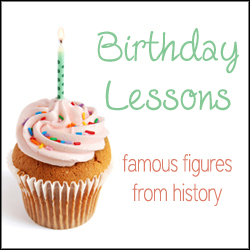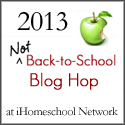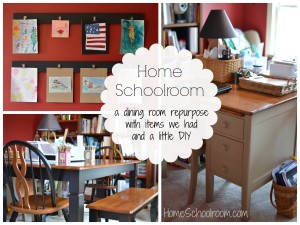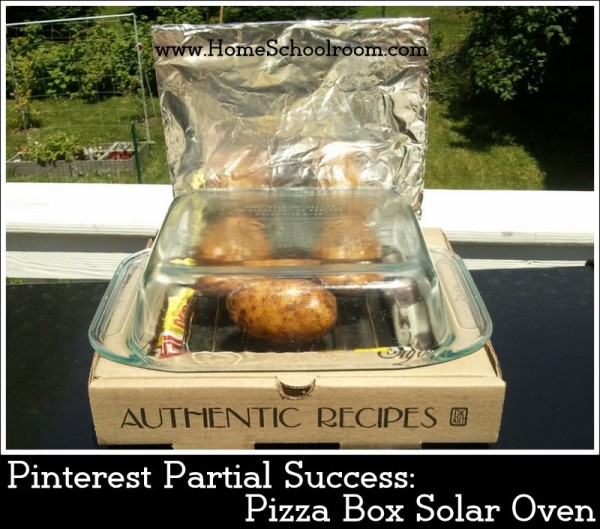 Hi, I'm Heidi and I homeschool my two sweet kids. I want them to know that learning is an exciting lifelong adventure! We love great books, unit studies, notebooking, lapbooking, and hands-on learning.
Hi, I'm Heidi and I homeschool my two sweet kids. I want them to know that learning is an exciting lifelong adventure! We love great books, unit studies, notebooking, lapbooking, and hands-on learning.Squirrel Nature Study

We have fallen in love with a squirrel who frequents the bird feeder on our deck. It’s rare to see squirrels or chipmunks in our neighborhood. Perhaps it is because we lack really old trees…or maybe it’s our abundance of outdoor cats. So our one backyard squirrel has become like a treasured pet.
Learning About Squirrels
One of the Outdoor Hour Challenges this month from Barb at the Handbook of Nature Study blog was a squirrel study, so it was a perfect time to do a more formal study of our favorite squirrel.
- We watched two videos Barb linked to on an older squirrel post. The first showed a squirrel’s acrobatic abilities, and is why my kids are requesting I install some sort of tightrope so our squirrel can cross safely from the trees to the deck out of the reach of cats.
- In addition to information and links from Barb, we learned about squirrels from the Handbook of Nature Study by Anna Botsford Comstock (a must-have nature study reference book).
- We checked out an older book from the library called The World of Squirrels.
- If your children are fans of the PBS show WildKrats check out the gray squirrel episode available on Netflix. My son loves the WildKrats and learns a lot from their show.
Studying Our Backyard Squirrel
Let me introduce you to Nutty. (Creative name, I know.) He’s a North American Red Squirrel. He’s smaller than a gray squirrel and very cute–don’t you agree?
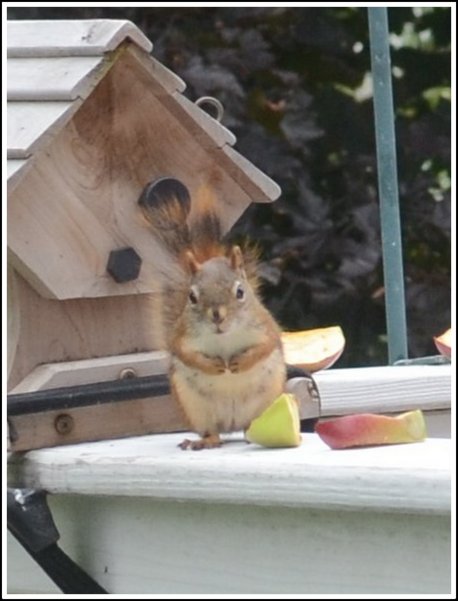
He spends lots of time tucked under the roof of our bird feeder eating sunflower seeds. He’s also tried peanuts and apples, though I would say the sunflower seeds are still tops for him. We read about squirrels eating the seeds from cones, leaving a pile of scales and remembered seeing little piles of scales and stripped pine cones on hikes this summer.
This week my son picked up a couple dozen acorns from a large oak tree on our walk and placed them all over the deck. Once Nutty discovered them he spent time busily grabbing acorns and burying them around our yard and garden.
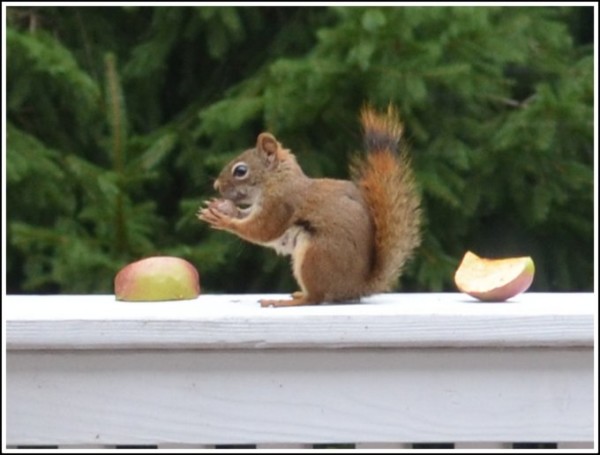
It was entertaining viewing: he’d grab one in his hands, place it in his teeth (squirrels don’t have cheek pouches like chipmunks), dash to what seemed like a predetermined spot (no searching around, just run right to it), dig furiously with his front legs, bury the acorn, then run back to a large spruce tree in our backyard that we think is his home.
Then he’d repeat the process: always running from the spruce tree across the swing set top, down the leg of the swing set, across the lawn to the maple tree, then across the lawn up onto the deck.
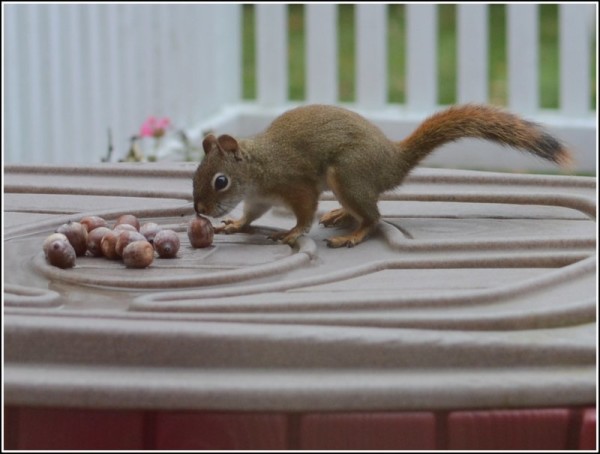
We learned that squirrels do not hibernate, but must eat regularly in winter. We look forward to seeing our little friend and making sure he has enough to eat through this winter that forecasters are predicting will be extra cold…if that holds true for Maine Nutty may need our help! We’re also wondering if Nutty will lose the black stripe on his side in the winter, since we read the black stripe is present only in the summer.
Adding Squirrels to our Nature Notebook
We recorded all that we learned on Barb’s free squirrel notebooking page (link to download is in the OHC post called “2009 set”). Part of the notebook page is recording the tracks. We read about the tracks in the Handbook of Nature Study, and looked online for an image of squirrel tracks. We remembered seeing squirrel tracks in fresh snowfall on a woods walk last winter.
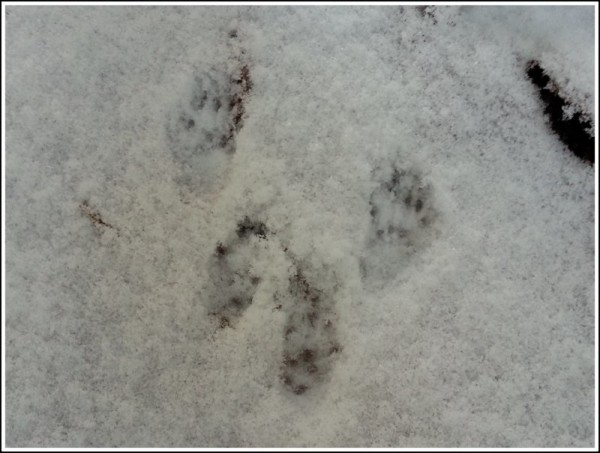
I’ll leave you with a conversation my son and I had this morning about Nutty. My son was wondering aloud if Nutty had a wife. Then he had another thought:
Or maybe he thinks: I’m not going to get married, then she’ll take all my nuts!”
My husband found this extraordinarily funny.
How Letting Go Has Led to a Better Lifestyle and More Learning
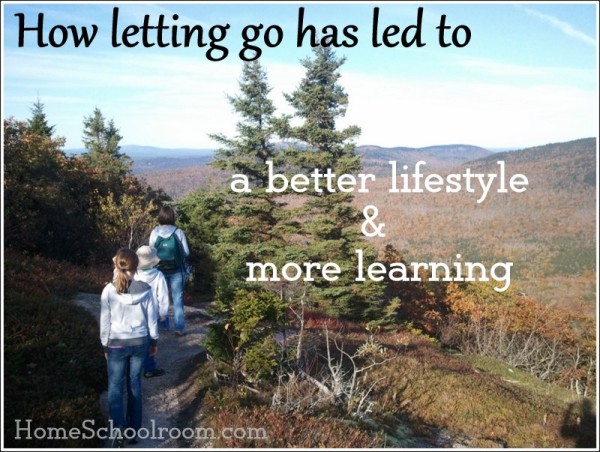
It’s about time I gave an update on how our homeschool year is going! Last spring I was feeling overworked and a tad burnt out. I wasn’t thinking of quitting, but I also wasn’t willing to go forward as is. I was always planning, online researching or writing, making lists I could never complete…basically trying to squeeze too much out of every day, sleeping less and wearing myself out mentally and emotionally.
I spent most of the summer reading and thinking, writing down my thoughts, praying, talking to my husband and just being with my family. We read and camped and had fun. I felt my tightened nerves loosen up. How silly that I’d gotten so wound up that I lost sight of my purpose. We brought our kids home for a better lifestyle–not a stressed out mama.
I read books by Ruth Beechick and Sally Clarkson. I made plans, but not too many. I wrote goals about what really mattered. My plans were much more focused on overall development and education and far less on what specific topics we would cover.
Probably the biggest change was my mindset. It’s not about planning the perfect day, unit or year, or how much I check off my list. It’s about our relationships with each other and our relationship with learning. I’ve endeavored to keep this simple checklist at the forefront:
- Are we relating well to each other?
- Did we learn and spend our time well today?
So, whether we’re working at curriculum or focused studies I’ve prepared, taking a field trip to experience the real world, or enjoying a hike to soak in nature’s beauty–it’s all good. At the end of the day I don’t stress over what we didn’t get done, I just smile over what we did.
I find my relaxation has opened the door to several benefits:
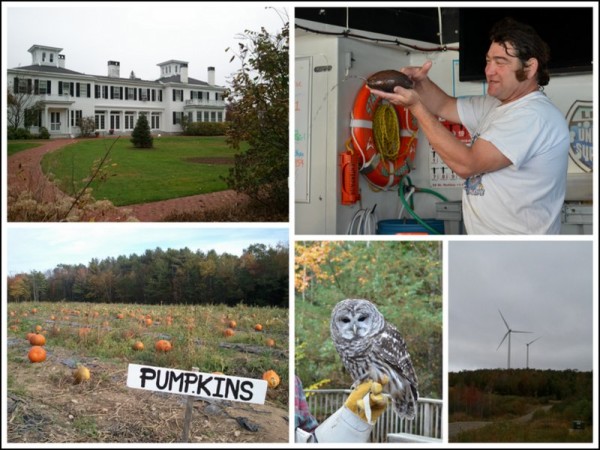
- We’ve enjoyed more real world learning through field trips, which had been one of the positives of homeschooling I was excited about when we started. We’ve visited a wind power facility, went out with Diver Ed, toured our state governor’s mansion, and got up close and personal with a Barred Owl.
- My husband feels welcome to step in and run with ideas he has for the kids–which has led to some incredible computer programing instruction.
- I see my kids both taking more initiative in learning. From writing stories to setting up paper airplane experiments, they’re exploring and creating more on their own.
- We have stored up some tremendous family memories spending time together doing everything from hiking new trails to taking off a school morning to go out for breakfast.
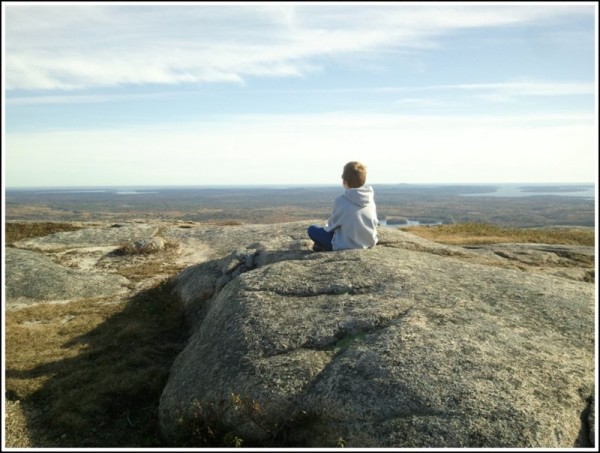
What has my life as a homeschool mom been like? I’ve spent less time planning and been on my computer a lot less. I’ve read more and kept our home a bit tidier. I’ve realized I don’t need to be looking online for the perfect activity to go with our Egypt study…I need to look my son in the eyes when he’s telling me about his Lego creation. I don’t need to be choosing the perfect wording for a blog post…I need to be choosing ways to connect with my adolescent daughter.
I’m content in what feels like a homeschool sweet spot. Adjustments will be necessary as my children grow and change, but I’m hoping I can stay focused on not becoming the unhappy, overworked homeschool mom. Just in case I need a reminder of what really matters, I’m saving inspiring posts on my pep-talk pinterest board.
How do you regain focus when you find you’re busy all day but not focused on what matters?
Thank you to the wonderful hostesses with fun link-ups on Fridays–click over to see what other homeschoolers are doing.
Moon Nature Study
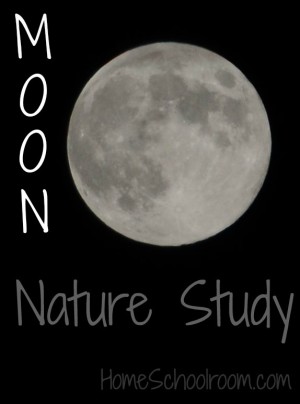
Why does the moon look so different each night?
Following along in nature study with Barb’s Outdoor Hour Challenges at the Handbook of Nature Study blog, we spent a month learning about the phases of the moon.
The first priority was observation: we looked at the moon any clear night from one full moon to the next. One night that involved a fun late evening ride in pajamas for a beautiful view from the local football field.
Note: I took the photo at the beginning of this post. If you want a good moon shot use your manual settings to basically underexpose the photo (my aperture was f/5.6, shutter speed 1/1250). To prevent blurring be sure to use a tripod, or if you’re like me and don’t want to go get your tripod just rest your camera on something stable–I used the post on my front steps. Voila, a moon picture to enjoy!
To record our observations we drew the moon several times for our nature journal as it changed throughout the month.

Tip: The kids traced a quarter to start with a nice circle and keep their moons a consistent size.
As with any study we read books from the library. Our favorite was The Moon by Seymour Simon. It has wonderful photos and information, including the stories of the Apollo space program.
Barb shared links to a couple kid-friendly YouTube videos that we enjoyed: one on the distance between the earth and moon in her Moon and Craters Study, and a terrific (and humorous) video on the phases of the moon in her post from a year ago on Moon Names.
To give my kids a better understanding of why we can only see parts of the moon sometimes we headed to the deep, dark basement for a hands-on demonstration of the moon phases. This idea was in the Handbook of Nature Study by Anna Botsford Comstock–a terrific nature study reference book.
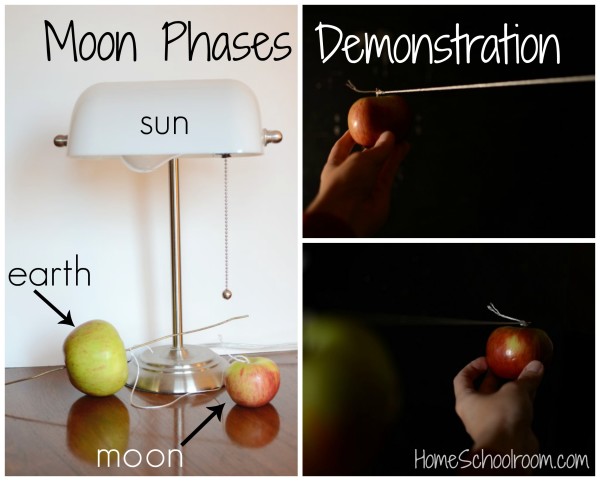
Basically the lamp is your moon, the apple mounted on stiff wire (I cut a piece of wire coat hanger) is your earth, and the small apple tied to the wire is your moon. Position yourselves to look from the vantage point of the earth apple, and you will clearly see the phases in the light falling on the moon apple. I love simple demonstrations!
An Aerial View of History With Brimwood Press
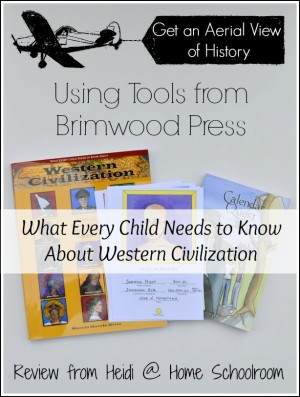
I’ve always had a terrible sense of direction. In fact, I can get lost coming out of a store at the mall. However, I find if I look at a map first to get the aerial view I understand the layout better and can remember where I’ve been and where I’m going.
This summer my children and I got the aerial view of history! We had focused on American history in the last two years and planned to begin Ancient history this fall. With perfect timing Brimwood Press offered me the chance to review What Every Child Needs to Know About Western Civilization.
Disclosure: I was given the curriculum materials from Brimwood Press free for review. This post details my honest opinion after using these materials with my children. I was happy to become an affiliate for Brimwood Press because I feel they produce a quality product for homeschoolers.
A Unique Approach to Studying History
This isn’t your ordinary history curriculum. Most programs are designed to take you through history and give a detailed look at time periods, civilizations, and the famous people of the past. Brimwood has created a product that is designed to do just the opposite: give you a quick overview (they call it a “jet plane ride”) of 5,000 years of history in about a month.
It isn’t just different because of how quickly it moves through history, it also takes the unique perspective of following the developments in our western calendar through the time periods. According to Brimwood Press:
By learning the story of the calendar, children develop a mental scope and sequence of 5,000 years of Western history to which all subsequent learning can be related.”
Why is a quick overview of history important?
I’m a big fan of getting lost in a time period. In fact, we immersed ourselves in pioneer times for a whole school year and loved it! But just like looking at one small section of map makes it hard to understand how to get from one area to another, spending long periods of time on one major period makes it hard to connect how contributions from one time period affect the future and the relationships between civilizations.
I wouldn’t want to spend all our history studies learning at this jet plane speed, but for getting an overview the speed is the key. Understanding the ways history has shaped our own culture actually makes our in-depth history studies feel more relevant.
What Every Child Needs to Know About Western Civilization Prepares Students for Timelines
I’m ready for my children to start compiling a historical timeline of their own (or, for Charlotte Mason homeschoolers, a “Book of Centuries”). This program was a great way to help my kids understand how we’ll be setting up our timeline notebook.
What timelines can do for children is to provide a framework into which they can put pieces of knowledge as they learn them. For this framework purpose, timelines should be very simple–so simple that children can memorize them.” Ruth Beechick in You Can Teach Your Child Successfully
The key historical periods memorized using the Hats of History cards is just that–a simple framework for my children to assist in future learning. Now as we go back and learn about the Sumerians and Egyptians, the Dark Ages and the Renaissance, they understand the overall road map and can see where we’ve been and where we’re going.
What Do You Need For What Every Child Needs to Know About Western Civilization?
Required Materials:
- What Every Child Needs to Know About Western Civilization is the teacher’s guide and student activity book in one. It contains all the historical information and activities, along with perforated cardstock pages for the Hats of History Cards and stickers for the back of the Hats cards.
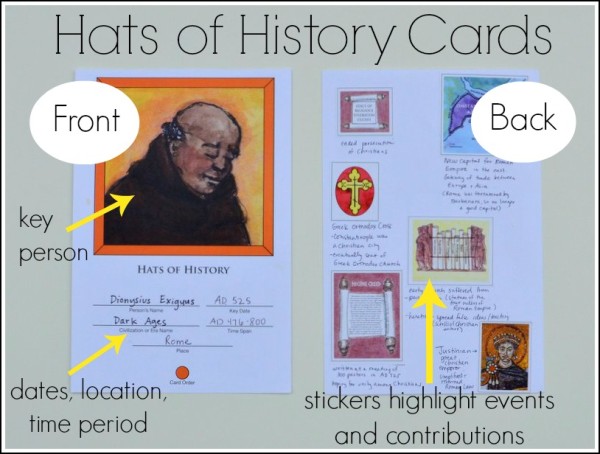
- Calendar Quest is a historical fiction book in which two children reluctantly end up time traveling with Father Time. He’s rather grumpy that people don’t understand the amazing calendar so he takes Lindsie and Evan on a trip through time to see how it developed.
Optional Items:
- Color the Western World is a beautiful large size coloring book with one page for each time period. This would be nice to keep a child’s hands busy while you read and be a good review tool as well. My children don’t enjoy coloring pages, so I merely put this out for them to look at while we worked through the lesson.
What Did I Like Best About Brimwood Press’ WECN?
- The Hats of History Cards were my favorite part of the program. As you go through the lesson you add stickers for major events, people, or contributions from that time period. I wrote small notes beside the stickers so we can use these cards for review. I love the resource they become: 14 cards covering major time periods with a color photo of a key figure, the dates and location, and important details. Before each lesson we made a game by covering the dates so my kids had to put the cards in order from memory.
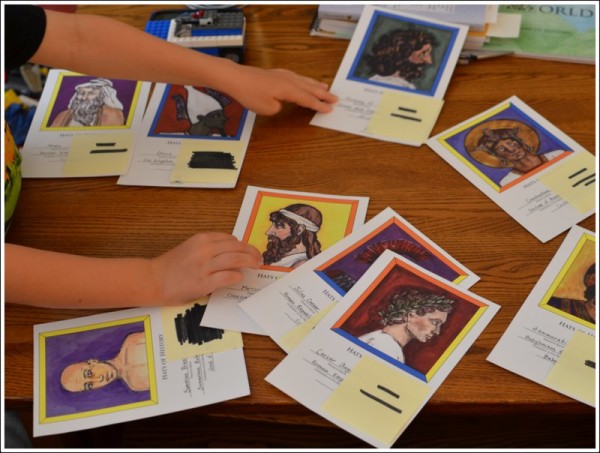
- The program is flexible. It’s meant to be covered in about a month, but you can move a little more slowly. For our relaxed summer schedule it took about two months. (Note: this is not designed to be used at the same time as other history studies. It would defeat the fast-paced design.)
- It works for a range of ages. Though the intended age group is grades 5-8 it’s easy to bring younger children along. My son enjoyed the Calendar Quest story and the hands-on component of the Hats of History cards and stickers.
- It’s a keeper. This entire product is worth keeping on my shelf. The guide is a great reference book for major events and contributions of historical periods. Calendar Quest is a book my children could enjoy in their free reading time. And I foresee going through this program again when my son is in the intended age range. My daughter would then be in high school and I believe would benefit from this quick overview to strengthen her understanding of the flow of history.
Was There Anything I Didn’t Like About WECN?
- I was going to complain that the maps for each lesson are not full page and in order to use them you must photocopy them from the guide which made it difficult to get a good copy of maps near the binding edge of the page. But nevermind, because now Brimwood Press offers the maps in a free download on their website! (Just scroll down the page for the pdf link.)
- This complaint is more of a personal preference, and is something my kids actually enjoyed: many of the historical characters in Calendar Quest are presented as a bit…silly. Cleopatra is more focused on her cat than what’s happening, Charlegmane is obsessed with making fur accessories from Lindsie’s guinea pig, and Pope Gregory just wants his lunch. While it makes for an entertaining read I did reiterate to my kids that I thought many of these people were probably quite serious about the topics at hand. That being said, I still found the book to be filled with historical information and my children were very engaged in the story.
Are You Interested in Learning More?
If you think your history study could use an aerial view, head over to the Brimwood Press website and check it out for yourself. There you can learn more about their products, view sample pages, and get ready for your jet plane ride through history!
Poet Study: T.S. Eliot
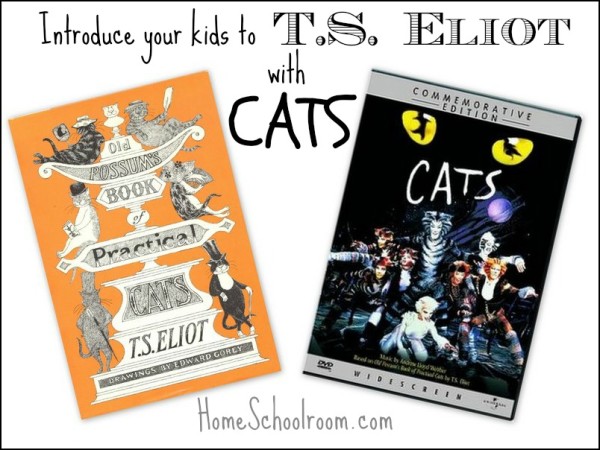
Introduce your kids to the poetry of T.S. Eliot with CATS! September 26th is his birthday, so it’s a great time to share this famous poet with your children.
The Amazon links are affiliate links.
Who is T.S. Eliot?
Thomas Sterns Eliot was born in America in 1888 but settled in England as an adult. He began publishing poems as a college student and went on to be one of the world’s best known poets. He died in 1965. You can read a biography from the Academy of American Poets.
T.S. Eliot Wrote Poems About Cats?
At first I feared my children were too young to enjoy his work, but then I ran across a copy of his book of poetry called Old Possum’s Book of Practical Cats. These poems about cats were written in the 1930s by Eliot in letters to his godchildren (using the name Old Possum). Later they were published in book form. We are owned by a Siamese cat and enjoy reading about cats with personality, so this book was a perfect fit for my kids.
The poems introduce amazingly creative feline characters. Mr. Mistoffelees (the magician), Rum Tum Tugger (who like our cat, “doesn’t care for a cuddle but he’ll leap on your lap in the middle of your sewing”), Mungojerrie and Rumpelteazer (a troublesome duo: ” down from the library came a loud ping from a vase which was commonly said to be Ming”), Bustopher Jones (who is “remarkably fat”), Macavity the villain, and more.
Poetry Inspires a Musical
The fun part is that T.S. Eliot’s book of cat poetry inspired the musical Cats. That’s right, Eliot’s poems were the inspiration for Andrew Lloyd Webber’s famous musical that made history playing on Broadway nearly 18 years! Fortunately you can enjoy a special production of Cats performed by a star cast on DVD.
Note: The dancers are mostly in tight leotards, as is typical for productions we’ve seen like the Nutcracker, but the dancing is decidedly different. For instance, there are video close-ups of Rum Tum Tugger’s Elvis-esque hip gyrations. I just wanted to forewarn you. When we started watching it I thought perhaps this wasn’t my greatest idea, but I’m glad we continued to watch and learn more about this iconic theater production.
If you have this DVD be sure to watch the section called “The Making of Cats.” It has interviews with some of the cast, Andrew Lloyd Webber himself, and many of the other people that brought the show to life for film. The work behind the scenes, from performing the music and dance just so to hand washing costumes and applying makeup is fascinating. The discussions about the very beginnings of the Cats musical and the characters and how they combine human and feline characteristics helped us understand, and thus enjoy, the show more. There is a storyline woven throughout, and I didn’t grasp all of it until we watched the background information.
An interesting story: Andrew Lloyd Webber visited T.S. Eliot’s widow to ask permission to make a musical. She informed him that Eliot had turned down Disney because he didn’t want the cats made into cartoon pussycats. Webber informed her he was thinking more “Hot Gossip” style. According to Wikipedia, Hot Gossip was a British dance troupe known for risque costumes and dance moves. Eliot’s widow says that’s just was he would have wanted!
As you come to know the characters they really grow on you, or at least they did for us. The vocals stay very true to T.S. Eliot’s original poems, and we’ve been singing their tunes around the house since we watched it…therefore my kids are singing lines from a great poet! Wonderful!
Visit the bloggers of iHomeschool Network starting on September 1st for ideas to celebrate other fascinating people born in September.
Mapping Out Our Homeschool Day
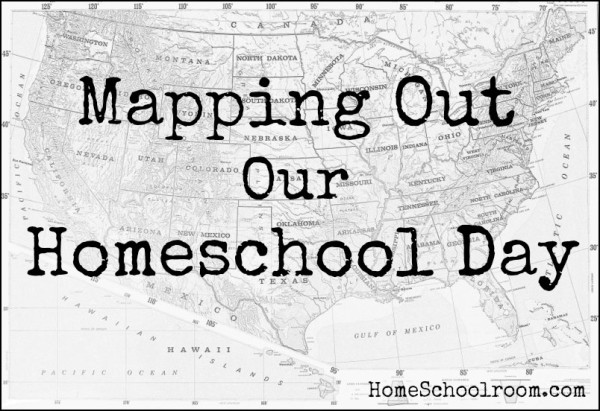
I aim to provide my children with a strong literature-based education, make time for beautiful things like fine art and music and nature study, and keep the joy in our family life. Here’s a peek into a day in our home schoolroom with a nearly eight year old boy and eleven year old girl as we enter our third year of schooling at home.
I’ll highlight some of the adjustments I’ve made to this year’s daily flow.
Rise and Shine at 6:00 AM
My early riser wakes me, already grinning and talking and planning inventions. I stumble downstairs in the general direction of coffee. He builds Legos and sometimes watches educational shows I put in our Netflix queue. I feed our dog, read a devotional, check email and snatch a few minutes to read, write, or plan.
Note: I used to read the Bible at night. Then I realized that just before bed when the house is quiet is NOT when I need the strength of God backing me up. It’s when I face the day of being mom, housekeeper, and teacher.
Get Ready for our Day at 7:30 AM
By now my daughter, now 11 and not an early riser, is awake, or I gently nudge her in that direction. We prepare ourselves and the kids tidy their rooms. They each have a checklist upstairs to prevent reminders from me to brush teeth or pick up dirty clothes.
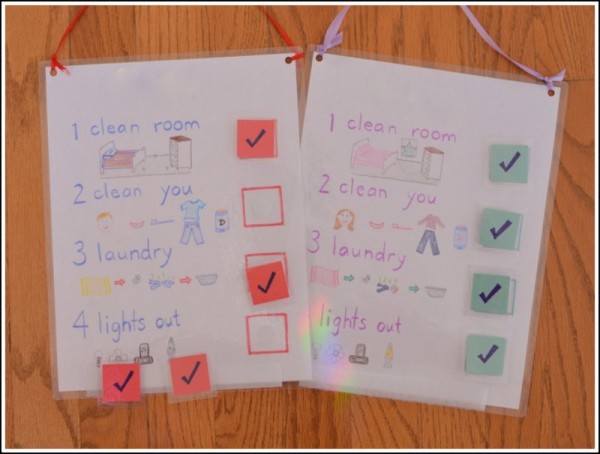
Note: We used to eat breakfast, then head upstairs to get ready for the day before coming back down to start school. Now we get ready first, then gather for breakfast and can move right into our schoolwork. It’s more efficient because we can linger at breakfast but it doesn’t hold up the flow of our day.
Breakfast and the Beginning of Learning at 8:30 AM
While eating breakfast we watch CNN Student News. It’s a 15 minute newscast meant for middle school and up, but we’ve enjoyed it for two years now. We pause frequently to discuss topics and locate places on a map. Breakfast is never dull!
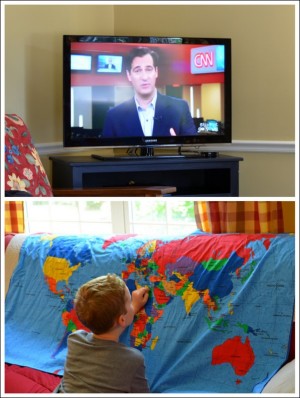
After the news we can move right into a bit of a morning meeting. I read our family devotional (this year we’re working through Our 24 Family Ways), we work on memory verses, practice Latin and Greek roots, pray and then start on individual work. For specifics of our curriculum plans for this year see this post.
My children each have weekly lists for individual work. These aren’t fancy printables, but simple checklists I create in a spreadsheet program. Some subjects must be done daily, other things 2 or 3 times a week. The lists give them direction, along with some choice and flexibility–and with that comes responsibility. If they don’t work diligently they will have to make up the work at another time.
I want to add that their lists are flexible. It says the subject, like math or Latin, but not the lesson number or specifics. That way if a particular lesson or topic is more difficult they’re not rushed. They just “do the next thing” in their subject, with daily progress as the goal.
Note: My new middle schooler probably won’t be able to finish her individual work in the morning time slot. She and I have discussed how more work is required at her age, but that we can’t extend the school day for her younger brother who (as an early riser) works best earlier in the day. So even if she hasn’t finished her individual work, she’ll pause and we’ll move into our joint subjects. She’ll finish her work either on Friday (we have four day school weeks) or later in the afternoons on quiet days.
Tea Time at 11:00
Having a hard break at the end of individual work is new for us. I shared our plans for tea time as a way to fit in our “extra” studies like fine art, music and poetry.

We’ll gather for a treat for our mind and stomach. This will provide a nice transition between the more structured learning of the basics and our subjects we delve into together.
Time to Learn Together at 11:30
This year I’m using a time block schedule instead of a list of goals. I read the idea in Educating the WholeHearted Child and see the benefits of this type of schedule.
Note: Last year I talked about not having set times, so why is going back to times actually more relaxed for me? Even though I’d realized the folly of fifteen minute time blocks, I was still over-planning. I made unrealistic lists and ended the day feeling too much was left undone. When I sat down to work with the kids I was so focused on the list that I tended to lose the joy and squash their questions because, dang it, I wanted to work quickly and cross things off my list!
There are only so many hours in a day, so much concentration they can give me, and so much patient interaction I can give them. Instead of lists I’m just blocking out the time and during specified hours I will focus on learning with them, and as long as we’re learning each day then the day is successfully completed.
A Learning Lunch at 12:30
While we eat I usually take advantage of a captive audience and we either listen to an audiobook, watch an educational show (like a science or history video), play an educational game, or work on notebooking.
A Breath of Fresh Air at 1:00
We head outside for fresh air after lunch. Some days we just take a walk around the block, other times we head somewhere a little more natural, and frequently we do a little nature study.
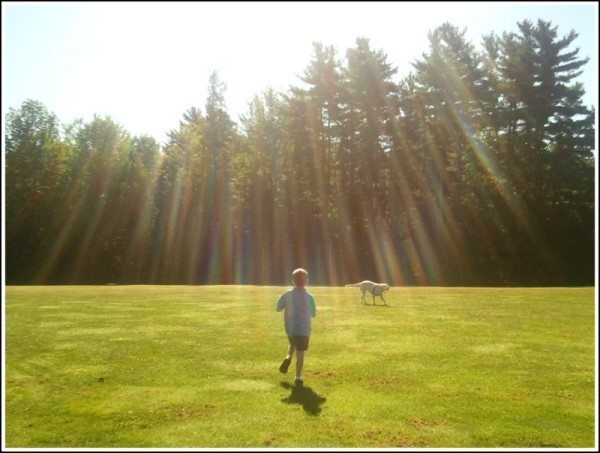
If it’s a nice day and they’re riding bikes or jumping in leaves or playing in snow I let them continue after I head back inside. Sometimes my son will stay out and my daughter may come in to practice piano or do other work.
Afternoon Variety
Some days we have somewhere to go: errands or educational things like music lessons, Girl Scouts or Boy Scouts, or various homeschool groups. Depending on how early we need to leave I still try to fit in quiet time, the daily habit I try desperately not to miss.
Other days where we don’t have to go anywhere right away we’ll fit in a little more learning together. We may draw a nature find, have a little hands-on fun with art, or perhaps try our hand at writing poetry. Fridays are also good days for fitting in some of these things or pursuing individual interests.
Ending the Day with Reading Aloud
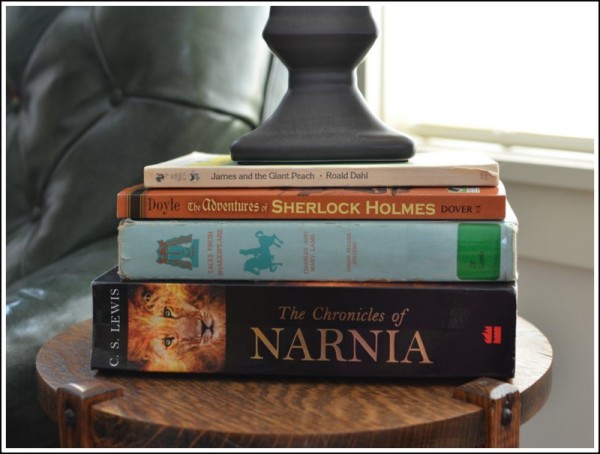
I read aloud during our school day for subjects like history, science, nature study, and fine arts. Most days we’ll read aloud again sometime before bed. It could be while Dad is preparing dinner (hooray for a husband who cooks!), when we’re all cozy in the living room, or while they eat a bedtime snack.
Just after Labor Day we’ll be diving in to our full time schedule, and I have to say I’m pretty excited to start this new year. Starting Monday, August 25th, you can read how other homeschoolers structure their day in the final week of the iHomeschool Network Not Back to School Blog Hop.
Our Home is Our Schoolroom
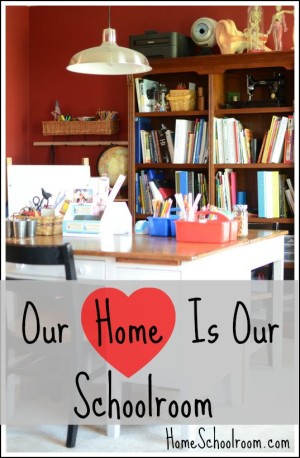
It’s so handy to have a dedicated room to call our schoolroom, but the longer we’re at this the more our “school” and “home” life are merging into one lovely lifestyle. Let me show you some pictures of our schoolroom and the other learning spaces that keep educational and interesting things within my children’s reach at all times.
I shared details about how we transformed our rarely-used dining room into our home schoolroom last year.
We used things we already had and some elbow grease to give new life to old items and in a couple cases make things we needed. In that post you’ll also find the directions for our easy to change art wall and our inexpensive large magnetic board.
Rearranging
We’ve changed a few things around since that post. I confess that I have rearrange-itis. I get urges to rearrange rooms all the time. Being open to repurposing and rearranging is one way I keep costs down…not to mention changing a room around is way more fun than just cleaning!
So, I moved the table we were using for a schoolroom table out into the kitchen. That worked better because we needed more elbow room at dinner time.
The little table from the kitchen became a computer table in our music/playroom. That worked better because my kids needed more room to spread out books and scratch paper beside the computer for Teaching Textbooks.
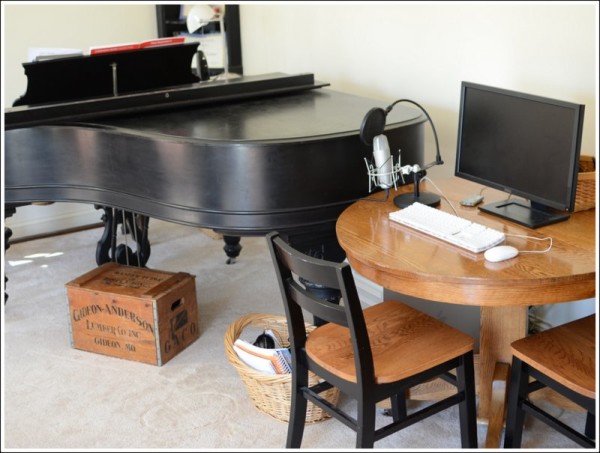
Desks from their rooms came downstairs to the schoolroom. This was a smart move because they rarely used the desks when in their room, and it gave them a lot more storage in the schoolroom. We keep the desks grouped together in the center of the room because we can easily converse and all have a nice view out the window.
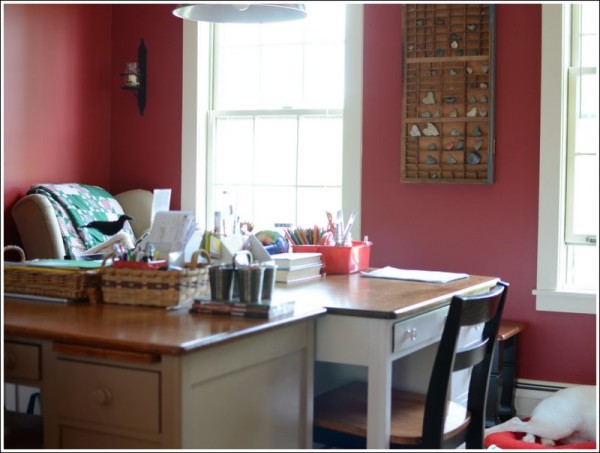
Geography Corner
I gathered all our geography resources to create a central Geography Corner. Now all our geography games, maps, puzzles, and a globe are near our giant pull-down wall maps. (I still nearly swoon when I pull down these maps. Yes, just $5 at a school demolition sale.)
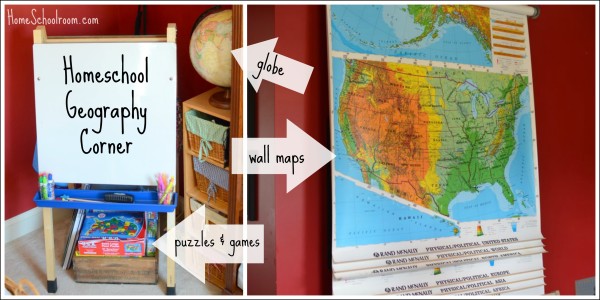
Command Central
I was going to call this area (with my beloved lockers) the writing center, but it has a lot of science and math stuff in it. So I made up something official sounding: Command Central.
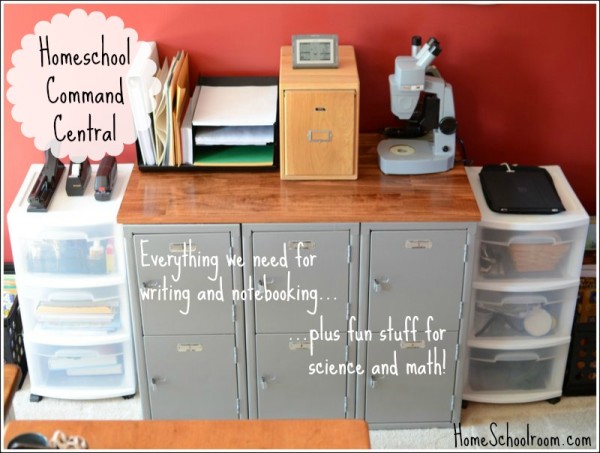
- For writing and notebooking you’ll find lined and unlined paper, envelopes, sheet protectors, a dictionary and thesaurus, stationery, graph and other specialty paper, along with tools like a hole punch and supplies like paperclips. There is a binder that holds notebooking pages my children can choose from if they don’t want to use plain paper. I’ve stocked it with general notebooking pages, plus a few styles of graphic organizers and books reports. I love this system because it keeps notebooking simple–no searching for specific pages online.
- For science there is a microscope and slides, a stereoscope, and all the science supplies that make you feel cool like glass beakers and goggles.
- For math there are manipulatives, scales and balances.
- Plus each child gets their own locker. Don’t let my kids say they’re missing out on any of the fun school kids have! I may even put combination locks on them someday just so when they get older they can have dreams like I do that they’ve forgotten their locker combination.
Bookshelves (You can never have too many.)
The large bookshelf in our schoolroom is packed full, and I organize it by person.
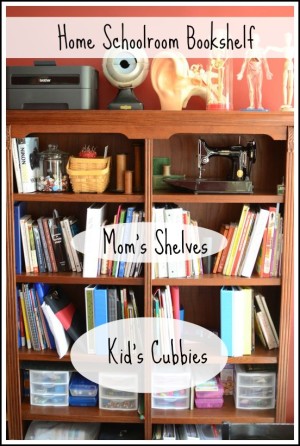
I use two higher shelves for my binders, reference books, teachers manuals and books I’m saving for upcoming units. Each of my children has two shelves: one for books, binders and notebooks, the other for school supplies. This bookcase also houses my sadly under-used sewing machine and on top science models and our printer.
My favorite homeschool supply is books, and there isn’t a room in our house that doesn’t have them. Bookshelves and baskets or boxes of books are everywhere you look in our home.
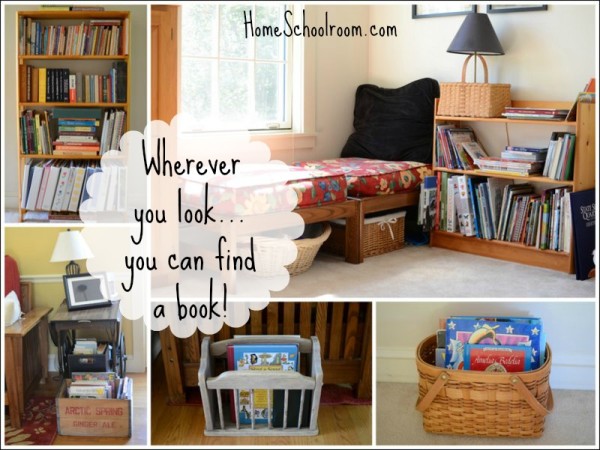
- Nonfiction science and history books are near a window seat. I also keep books here that are just fun to look at like Waldo or spot-the-difference type books.
- Library picture books have their own box beside the couch. Just above them is a box with chapter books and devotional books we’re reading aloud.
- Poetry books are next to a comfortable armchair in the living room.
- Just outside their bedroom doors is a basket of audio picture books we have on audio. My husband has recorded some of our favorite books for our children. They love to listen to his voice reading them!
- In the upstairs hall is a bookshelf of chapter books and our previous year school binders. (Note to self: we need more bookshelves.)
- Each of my children also has a bookshelf in their room for favorite books they’ve collected. In the schoolroom my daughter has her own basket of chapter books she’s working on and my son has a crate of just-right-for-him books.
Nature Table
Our nature table is located in a highly trafficked spot.
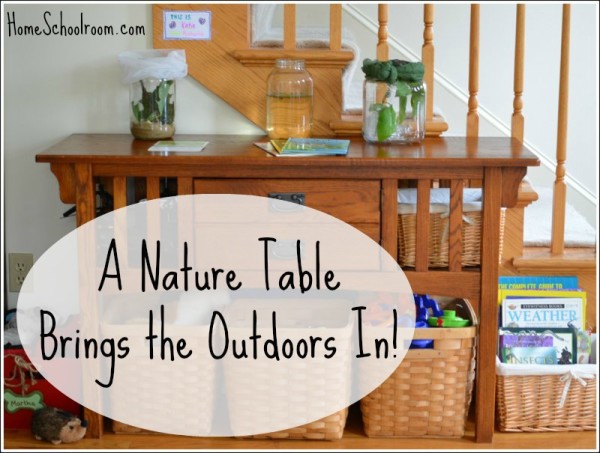
I rotate items through to keep it interesting. In a basket on the floor are all our field guides. I stack books on the table related to what’s on display, sometimes from our collection and sometimes from the library. Items that will keep for a long time but aren’t on display right then I keep in shoe boxes in the basement.
Storing Art and Craft Supplies
Supplies for crafts and art projects reside in a hutch near the kitchen. I shared the supplies I stock to fuel my children’s creativity.
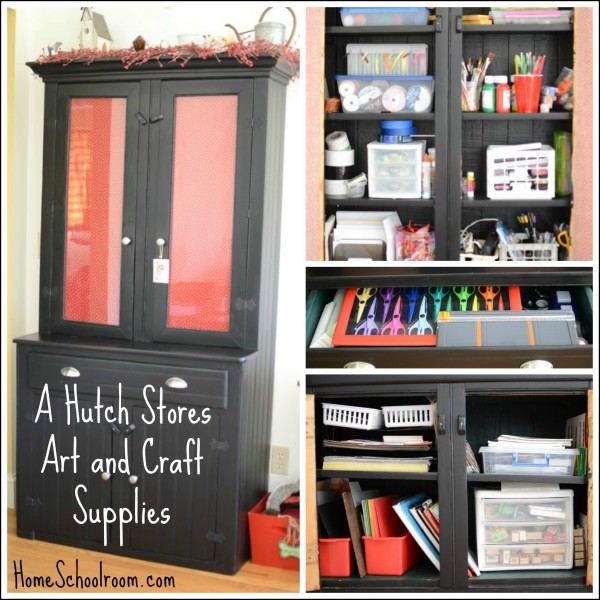
Education is our Life
School spills over into home, and home spills over into school. The schoolroom is a great hub, but our whole house works to enrich our lives. It’s a great place to spend our days.
Need more ideas for organizing your learning spaces? Hop over to iHomeschool Network’s NOT Back to School Blog Hop where everyone is sharing their homeschool rooms.
2013-2014 Homeschool Curriculum and Plans
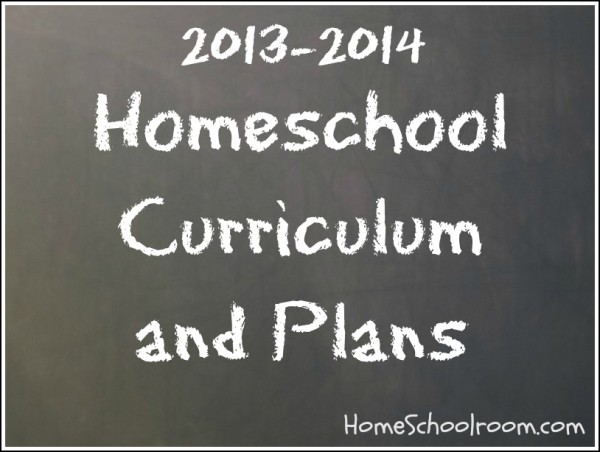
I continue shaping my homeschool philosophy and fine-tuning my methods as I educate my children. Before I go into my specific choices, these are the books that I’ve read over the summer that have had the greatest impact on my plans for this year.
This post contains affiliate links, but these are products I actually use and love.
- Ruth Beechick’s Books The Three R’s (Grades K-3) and You Can Teach Your Child Successfully (Grades 4-8): I devoured these immensely readable, practical books.
- Educating the Whole-Hearted Child by Clay and Sally Clarkson: This book is loaded with information and required digesting in pieces, but helped with the overarching purpose of all this work of homeschooling and the general family life we’re trying to create.
These books align with much of the Charlotte Mason literature-based philosophy that appealed to me since we started homeschooling, but have given me the confidence and practical ideas for applying those ideals in a real-life modern-day home(school). Instead of filling my shelves with expensive curriculum I’ll use temporarily, I will fill our shelves with terrific books that we can enjoy and turn to again and again for instruction and inspiration. So we’ll use little less curriculum and more living books; less elaborate activities to go with our studies and more time-tested techniques like copywork, dictation and narration.
Without further ado, here are my plans for our third year of homeschooling with my 11 year old daughter and almost 8 year old son:
Language Arts
Copywork and Dictation
I’ll use this powerful, simple tool to work on many aspects of language arts. No fancy program needed: I’ll choose sentences (or paragraphs) from books we’re using, meaningful scriptures, and quotes from people we’re studying. We’ll go over the sentence(s) together, discussing interesting words or grammatical features. Each of my children will use a simple lined notebook for our lessons. Ruth Beechick’s books provided information on the progressive steps of copywork and dictation as skills grow.
Spelling
I’ll use a personalized approach to spelling (detailed nicely in both of Ruth Beechick’s books and A Charlotte Mason Companion). My modern day tweak is to add their personalized lists into the Spelling Bee app for practice and testing.
Writing
- We already keep journals where each child and I write notes back and forth to each other. I’ll do a whole post on this sometime–it’s been a joy to me and one of our best writing practices. We’ll do more creative writing in the form things like a Christmas newsletter and letters to friends, and use ideas from my Language Arts Pinterest board.
- With my daughter, and possibly my son, too (though he’s a bit young) I plan to work through lessons in creative writing shared by Ami from Walking by the Way and Sarah from Small World at Home. They both posted wonderful lessons they used in a co-op setting and I think we’ll have lots of fun with this at home.
- The books I read over the summer left me feeling a bit empowered to not use a formal writing curriculum. However, nonfiction writing and essays are not the type of writing my daughter naturally gravitates to, so I will consider a formal curriculum to use part time to fill in gaps. We worked through Writeshop Junior D and I may jump into WriteShop I after the new year. The creative writing lessons should keep us quite busy until then!
- I do know that we will not use a formal grammar curriculum, but will just have a good grammar reference book that she learns to use well and work on grammar within her writing (not in a workbook).
Reading & Literature
- My son’s biggest goal is to increase his reading skills and my plan for that is very simple: he will read to me every day. We’ve been doing this over the summer, and not only is he improving a lot, he is really seeing the joy in reading.
- I will prepare a literature list for my daughter from Honey for a Child’s Heart and Read for the Heart. I’ll provide more choices than she needs to give her some options, but require reading a minimum of one chapter each day. She can choose her free-reading books (with oversight from me).
- My friend and I will hold a very informal book club of classic literature. Our families will read the books and meet to discuss them.
Math
Teaching Textbooks is the love of our math life.
- My daughter will begin Math 6. By the way, one of my fears when we switched was about its thoroughness and test scores dropping because of comments we’d read online. After working through all of Math 5 and our standardized tests I can say my fears are relieved and we are happily continuing with this computer-based program.
- My son will start Math 3. I am thinking we may need to break up lessons if they are as long as the Math 5 lessons were, but I have no problem letting him listen to the lecture at one sitting and doing the problems the next time.
With both children we also like to play with math through cooking or other real-life math and reading living math books.
History
After two years of American History (what fun we had!) it’s time to move into Ancient History. We’ll use Story of the World Volume I to keep us on track, adding in a lot of quality literature (using selections from the SOTW Activity Guide and All Through The Ages) and some extra hands-on fun from the Activity Guide only when it’s easy and educational. Remember, I’ve learned my lesson about over-planning.
Simple narration through notebooking will be how my children process and record what they’ve learned. I won’t be searching for fancy notebook pages: simple lined or unlined paper, or one of a few general notebooking pages I have available in a binder for them to choose from.
Science
We won’t use a formal curriculum but we will incorporate lots of science. I want to leave time to go with the flow because my son is loaded with science questions and curiosity. We’ve worked a lot on biology so it’s time to get messy with chemistry and have fun with physics. I have a multifaceted plan:
- I want to pick up some Janice VanCleave books (we have biology but I want to buy physics and chemistry), and we’ll try a free Susan Kilbride unit study on molecules (with the idea of purchasing her unit study book if I like the freebie).
- I bring our literature-based philosophy into science, too: we check out science books each time we visit the library, and I plan to read science books related to our history studies (All Through the Ages has suggestions for books on the history of science).
- We love fun science shows like Beakman and Mythbusters (both available free on Netflix) and extras like Science Friday videos (on Youtube).
- And don’t forget a hallmark of a CM education: nature study. I use the Outdoor Hour Challenges and other ideas from Barb’s wonderful blog and newsletter, use the Handbook of Nature Study as our spine, and jump into as many interest-led nature topics as we can (which is a little harder in January in Maine).
We’ll use the same simple tools of narration through notebooking that we use in history when applicable.
Art
This has been sorely neglected as I tended to plan large, elaborate projects. But this year I vow to be hands-on in art more regularly and here is how I plan to follow through:
- Drawing: I want to work on the simple art skill of drawing with my children. I often overlooked drawing feeling it was too easy or simple for me to focus on. But during many of our studies (history, science, nature) they use drawing to record observations. Not to mention that when we sit to draw together it is so relaxing! So I’m going to actually make drawing a subject this year (but be cautious not to sap the fun out of it). I’ll use Drawing with Children and Mark Kistler’s Draw Squad for instruction.
- Other than drawing I plan to get out art supplies once a week and just tell the kids to go for it: paint (watercolors, tempera, acrylic), pastels (chalk and oil), or clay (we adore Sculpey).
- I’ll also aim to do a lesson out of Storybook Art, Art Treasury, and my Art & Artist Study Pinterest board now and then to introduce them to new tools or techniques.
The Extras
I wrote about my plans for Tea Time to fit in the extras that add a lovely element to our homeschool. During our daily tea time this is what we’ll do:
- We’ll use Harmony Fine Arts Grade 5 plans to go along with our Ancient History studies. I love how easy it is to incorporate Charlotte Mason style art and music appreciation using Harmony Fine Arts plans. The Grade 5 plans are a little different than other years but will be extra fun because we’ll learn about ancient art and the beginnings of the orchestra.
- Mary from Homegrown Learners has made it very easy to incorporate great music in your homeschool with her SQUILT Music Appreciation Curriculum. Using the information from Mary and the technique of Super Quiet UnInterrupted Listening Time to study one great piece of music at a time is easy to implement, even for those of us with no background in classical music.
- We enjoy reading poetry aloud and I’ll continue with our relaxed style of reading from anthologies. We’ll also sometimes focus on one poet or style of poetry for short periods. When inspired we might try our hand at writing some of our own!
- I adore hymns and the beautiful history and messages within them. Mary from Homegrown Learners and Judy from Contented at Home shared wonderful ideas for hymn study.
Project Based Learning
My eleven year old daughter is ready for some truly self-directed learning, so I’m leaving room in her schedule for independent project-based learning. I’m still formulating my full plan, but I’ll be using ideas I’ve gleaned from Cindy at Our Journey Westward and Jamie at The Unlikely Homeschool.
Well, that’s is the super long-winded version of a peak into my homeschool plans. I’m linking up with iHomeschool Network’s blog hop for curriculum week. Hop over to check out other homeschooler’s plans and link up your own!
Homeschool Planning Pitfall: You Can Have Too Much of Good Thing
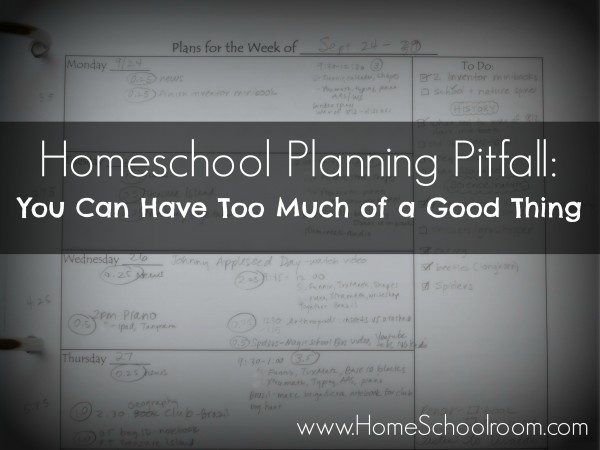
Since taking on the huge responsibility of homeschooling my children my natural personality trait of being task-oriented has been in overdrive. My tendency to obsess over details, set unattainable goals, and over-plan keeps my brain and body running at full speed trying to “get it all done.” During the last part of our school year I felt myself running on empty.
After the school year I took the time to review our curriculum choices and every aspect of our homeschool looking for successes and struggles. I went on a date with my my husband to ask his thoughts (I’m constantly sharing my thoughts with him). I interviewed each of my children separately. I read (or re-read) books that suit my homeschool philosophy.
I know that since life and my children are always changing I’ll never get everything “figured out,” but there are areas that need an overhaul, and a major one is planning. You know the saying, life is what happens when you’re busy making plans? Well, that could apply to my homeschool planning over the last two years. I spend way too much time researching, making lists, fretting and adding to our full plates. Being prepared and planning for your homeschool is a good thing, but I need to adjust how and what I plan.
Homeschool Planning Problem #1: Trying to Group All Topics Into Themes and Units
When I come across resources, whether books, videos, field trips, or anything else educational, instead of jumping in and enjoying it I struggle to pull all resources about the same topic together. I can spend an extraordinary amount of time researching books, activities and videos about a topic. This can actually lead to less time spent interacting with my kids (not to mention cleaning my house).
Here’s a typical scenario: My son asks when the bicycle was invented. Instead of answering his question with a simple web search or by checking out a library book I think: “Let’s do a whole unit on transportation!” I spend weeks pulling together ideas only to find he’s on to guitars.
Solution: Save themes and units for holidays and special occasions.
I will probably need frequent reminders to stop trying to group everything into tidy units. The themed unit studies with coordinating activities I see online look wonderful, but with my introverted personality and kids growing older, less me leads to more independent learning.
When students learn pre-selected information, pass a test, and receive a grade, they tend to feel that they have “finished” a subject. They close the door on that chapter, soon forget a large part of the information, and have no open questions that they intend to search out answers for. So as teacher, you do not have to be an “answer giver.” That should take pressure off practically all of us.” ~Ruth Beechick in You Can Teach Your Child Successfully
Instead of trying to group everything, I need to trust my children’s ability to make connections with information they learn.
The ideas required for the sustenance of children are to be found mainly in books of literary quality; given these the mind does for itself the sorting, arranging, selecting, rejecting, classifying.” ~Charlotte Mason (vol 6 p. 117)
Homeschool Planning Problem #2: I plan elaborately.
This problem goes along with my desire to make units out of everything: I tend to go overboard and I can spend as much (or even more) time planning as our lessons take. I strive to find every resource on a given topic. I try to learn information ahead of time to then teach to them in an engaging way, with preparation for hands-on activities, printing and cutting out minibooks, or finding the right notebooking page. I’m wearing myself out and losing the joy of learning alongside my children. I can even feel a bit offended if they don’t “ooh” and “aah” over my facts or techniques.
If your children sense that you are more concerned about the structural details of your unit than you are about the joy of learning, they will not be free to learn. If you are uptight, they will be uptight. If it becomes a test of your teaching ability, it’s time for a change.” ~Clay & Sally Clarkson, Educating the WholeHearted Child
Solution: Stop trying to put on a show for my kids.
I need to stop planning elaborate lessons and activities that are more entertainment than education. After years of leading Girl Scouts and teaching Sunday School and throwing themed birthday parties I still planned homeschool like that. But this is now our life and it needs to run differently. I realize I’m actually doing my children a disservice because it allows them to be passive.
The whole thing must be highly amusing to the teacher, as ingenious amplifications self-produced always are: that the children too were entertained, one does not doubt. The teacher was…in fact, acting a part and the children were entertained as at a show.” ~Charlotte Mason (Vol 6 p. 116)
In fact, I have so many thoughts on the labor-intensive activities I was planning that I’ll have to address that in another post.
Homeschool Planning Problem #3. I plan more than we can complete.
I’m very prone to this both in my personal to-do lists and in our schoolwork. I get caught up in the details and what I think we need to be doing. So many ideas look interesting, educational, fun, worthwhile and even necessary. The more resources I find the more I add to my list of things to do. Add to that curious kids and a dad who likes to jump in with ideas and I always plan too much.
Though it’s great to not run out of ideas, planning more than we can do leaves me feeling behind. I feel overwhelmed even though they’re always learning and making progress. I loose the joy of discovery and learning and just notice what didn’t get crossed off my list. I go to bed at night fretting over what I didn’t do that day, and wake up up in the morning with a heavy feeling that there is too much to do that day.
Solution: Pin it and forget it.
The internet is a wonderful resource, but I see so many good ideas that I over plan or feel we aren’t doing enough. Going forward, I vow to add ideas to my Pinterest boards so they are there for inspiration, then let them go. (If you have the same problem but aren’t on Pinterest, just substitute paper lists, browser bookmarks, or however you save ideas.)
This doesn’t mean I won’t ever do those great activities and use those great resources, just that they won’t be on my list of “have to dos.” They’ll be there when I need them—not lost but not required. So many things are good but we can’t do everything! And I’ll remind myself that as long as we’re learning every day all is well. Focus on making progress and enjoying life, not worrying about what didn’t get done.
Many thinkers have stated that it is better to study less and learn it well than to study more and learn only superficially.” ~Ruth Beechick in You Can Teach Your Child Successfully
I hope sharing my struggles helps some other planning-till-you-drop homeschool mom. And hopefully putting it in writing will hold me accountable to simplify my planning and rely more on great literature to be the teacher for my children.
I’ll let you know how I do, okay?
Trying a Trio of Pinterest Projects
Pinterest is a very helpful tool and has replaced my browser’s bookmarks as a way to save projects for later. The photos make it so much easier to scan through my links. We thought it would be fun to have a little Pinterest Challenge at iHomeschool Network to encourage us to complete some of those pretty pins.
Here are three projects I gave a whirl: one complete success, one that required a little tweaking to be successful, and then one that hasn’t succeeded fully–but I’m not giving up!

Project #1: An utterly delicious ice cream topping.
Have you ever ordered a chocolate dip cone at an ice cream shop or used homemade shell topping from the grocery store? Well, Family Fun hasan easy recipe for a homemade version that is not only scrumptious, but easy and made with items I keep on hand. Homeschoolers can point out the science, too: how our coconut oil is liquid at high temperatures but solid when cool, so mixing that with chocolate helps give us that thin coat that hardens on contact with ice cream.
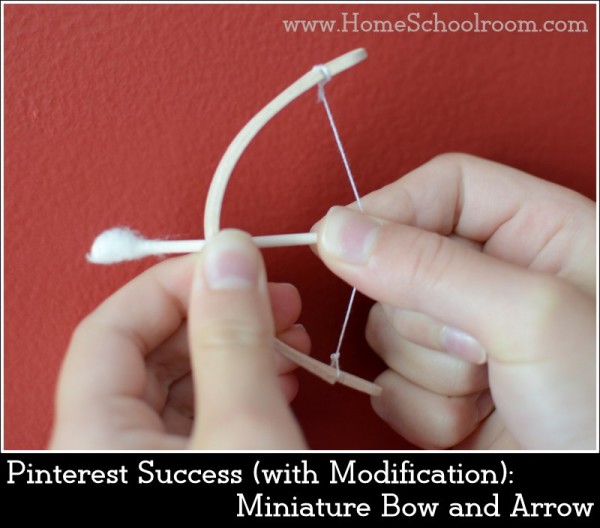
Project #2: Mini Bow and Arrow Craft
My son has been wanting to make this miniature bow and arrow for months, so this challenge prompted us to give it a try. Following the directions exactly our first attempt was fun but needed some tweaks to really work well.
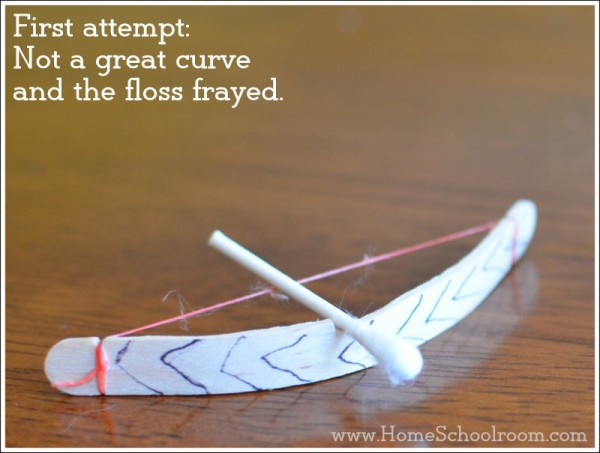
We didn’t get a great bend in our popsicle stick–it was hard to hold the tension on the curve of the wet stick while tying floss. Also the floss was not durable–it stretched over time (losing even more of the bend in our stick) and began fraying with use. Maybe I buy cheap floss? The coating also made their fingers sticky and scented.
I remembered another pin I have for making bracelets from popsicle sticks, so I used the directions there. You soak the sticks, put them inside a glass to form the arch, and allow them to dry there.
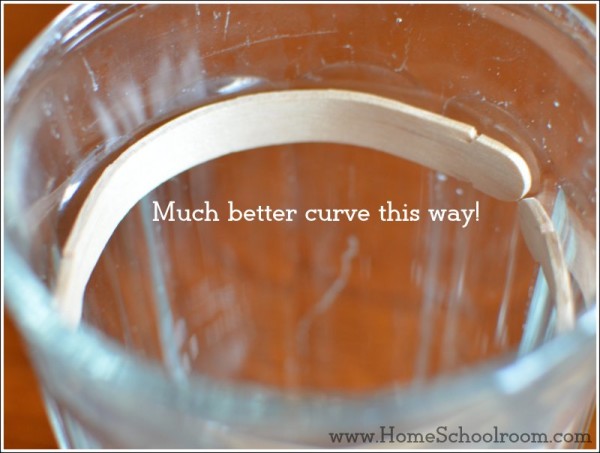
This gave us a beautiful bow that kept its shape (even now, a couple weeks later). My second tweak was to skip the fraying floss and use a stronger string. In our case I used craft thread. This made a more durable bow and led to quite a bit of fun with target practice and experimenting for the kids.
Project #3: Pizza Box Solar Oven
I’ve been wanting to try a solar oven forever! I used instructions from Home Science Tools; they even have a PDF with recipes to try. I followed the instructions as closely as I could. I built up quite a bit of heat (175 degrees was the highest) and my potato was hot, but not fully cooked.
I see a couple reasons for my failure:
- I chose a tricky food for my first try, I think–a baked potato. Unlike hot dogs or s’mores that many solar oven recipes prepare, you need some serious heat over a long period of time to bake a potato. But hey, I’m never one to take the easy way out.
- I had a couple small openings behind the glass pan that allowed heat to escape. Plan: Block any place air can exit!
- I had three potatoes, which created a lot of thermal mass for a small oven to heat. This site has wonderful information about the science and history behind solar ovens. I’ll try with one potato next time.
- I didn’t have enough time–I started around noon and then didn’t check on it the last hour so it ended up being in full shade when I checked at 5 o’clock. I lost valuable cooking time! Next time I’ll start earlier and remember to check frequently.
Like I said, I’m not giving up yet! In fact, I love that this didn’t work the first try. It gives me a chance to model for my kids “If at first you don’t succeed, try, try again.” They were very skeptical so now I’m determined to show them that we can bake a potato using power from the sun!
If you’re looking for more ideas for your homeschool or fun with your kids, visit my Pinterest boards. Do you like using Pinterest to organize ideas? And do you often get a chance to go back and actually do those wonderful activities?
Pop over to iHomeschool Network to visit other bloggers who tried out some of the projects sitting on their Pinterest boards.




